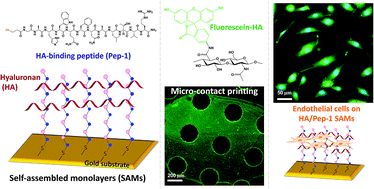Mimicking the endothelial glycocalyx through the supramolecular presentation of hyaluronan on patterned surfaces†
Abstract
The glycocalyx is the immediate pericellular matrix that surrounds many cell types, including endothelial cells (ECs), and is typically composed of glycans (glycosaminoglycans, proteoglycans, and glycoproteins). The endothelial glycocalyx is rich in hyaluronic acid (HA), which plays an important role in the maintenance of vascular integrity, although fundamental questions about the precise molecular regulation mechanisms remain unanswered. Here, we investigate the contribution of HA to the regulation of endothelial function using model surfaces. The peptide sequence GAHWQFNALTVR, previously identified by phage display with strong binding affinity for HA and named Pep-1, was thiolated at the N-terminal to form self-assembled monolayers (SAMs) on gold (Au) substrates, and microcontact printing (μCP) was used to develop patterned surfaces for the controlled spatial presentation of HA. Acetylated Pep-1 and a scrambled sequence of Pep-1 were used as controls. The SAMs and HA-coated surfaces were characterized by X-ray photoelectron spectroscopy (XPS), contact angle measurements, and quartz crystal microbalance with dissipation (QCM-D) monitoring, which confirmed the binding and presence of thiolated peptides on the Au surfaces and the deposition of HA. Fluorescence microscopy showed the localization of fluorescently labelled HA only on areas printed with Pep-1 SAMs. Cell culture studies demonstrated that low molecular weight HA improved the adhesion of human umbilical vein endothelial cells (HUVECs) to the substrate and also stimulated their migration. This research provides insight into the use of SAMs for the controlled presentation of HA with defined size in cultures of HUVECs to study their functions.

- This article is part of the themed collection: Nanolithography of biointerfaces


 Please wait while we load your content...
Please wait while we load your content...